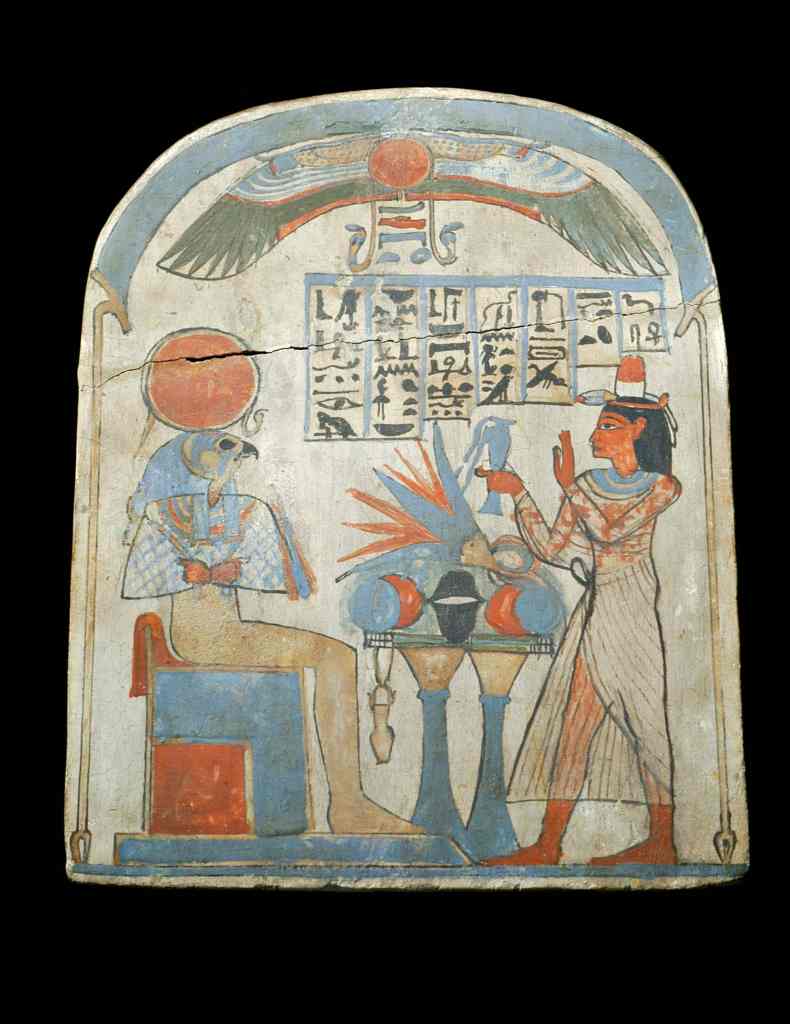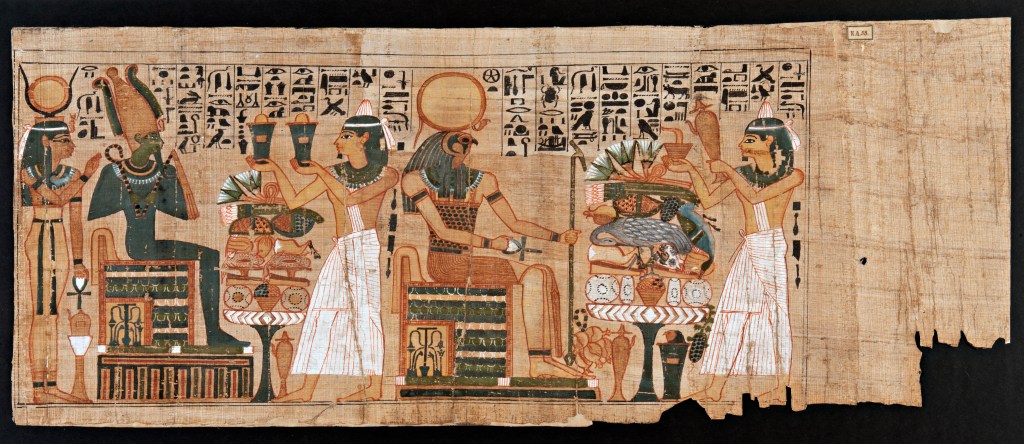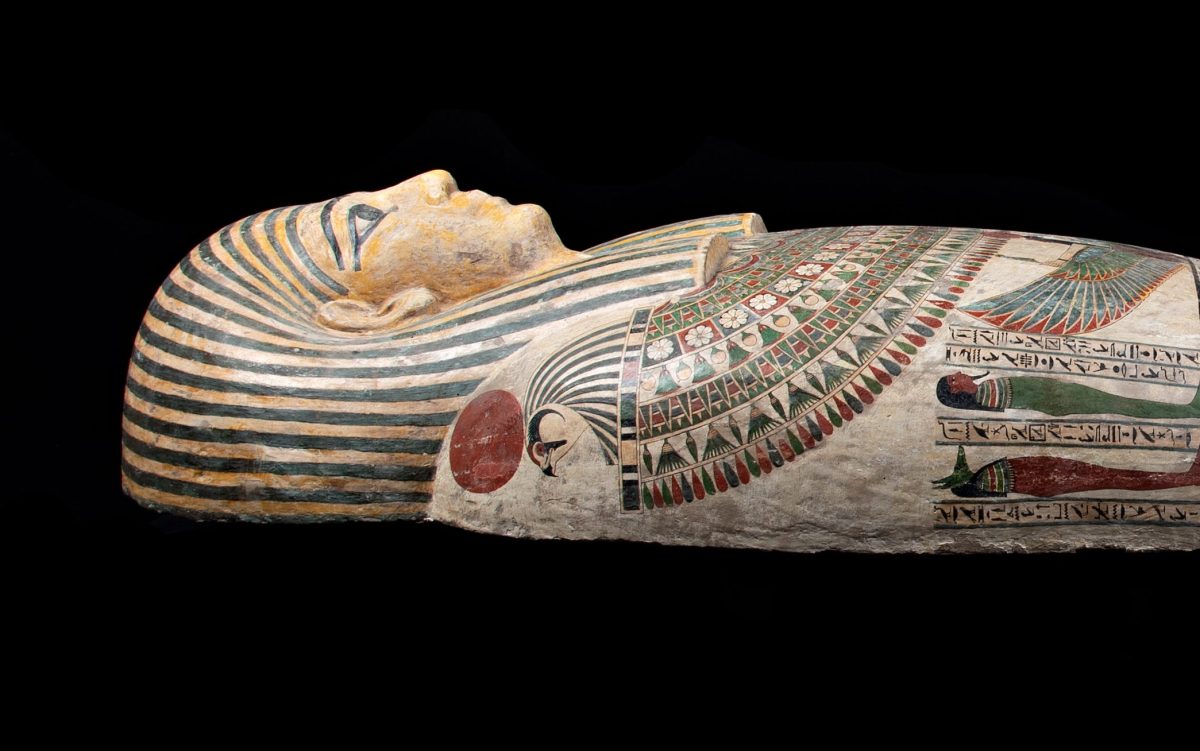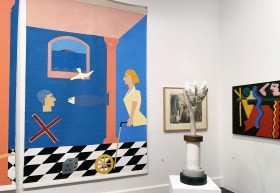WA Museum Boola Bardip’s Discovering Ancient Egypt exhibition facilitates figurative travel through time, from Prehistory and the Early Dynastic periods, to the Old Kingdom and beyond. It contains hundreds of artefacts illuminating aspects of Egyptian history, along with a variety of interactive displays and audiovisual aids. Each section within the exhibition space contains the perfect dark/light ratio for atmospheric awesomeness and artefact preservation.
Thematic focus includes – but is not limited to – the afterlife, monuments, scribes, mummification and the concept of eternity. Throughout the entirety of the exhibition, outstanding graphic design elements complement and elevate aesthetic display decisions.
Immediately upon entering, visitors are introduced to the exhibition space by a virtual façade replicating the 2000-year-old Temple of Taffeh. This visually impressive feat of narrated projection mapping underlines the vital link between past and present worlds. Further on, a wall-length timeline visually demonstrates the passage of time, both in terms of our own distance from this ancient civilisation, and the overall scale of Egyptian history.
This exhibition showcases a variety of written artefacts, including hieratic script written at the court of Ramses II, and a coptic bible fragment from the Medieval Period containing first-hand accounts of Jesus-adjacent crucifixions. Hieroglyphs were an important part of ancient Egyptian culture, despite literacy being a privilege reserved for the powerful.
A mythological papyrus from the Third Intermediate Period remains shockingly vibrant with stark whites, smooth blacks and golden browns. The Book of the Dead texts comprise hundreds of spells intended to assist with the transition to the afterlife. Several of these renowned papyri are on display, and are breathtaking to behold.
A 1972 replica of the Rosetta Stone situated near a series of 19th century photographs complements the more ancient items on display. This juxtaposition intentionally underlines the changing perceptions of ancient peoples by modern counterparts, and reminds us that much of what we know of the past is filtered through the biases of other eras and cultures. Discovering Ancient Egypt draws self-aware attention to this fluid lens across multiple instances; for example, in the light-skinned 1990s facial reconstruction of Sensaos, and the Roman Period painted panel, depicting the idealised face of a mummified man.

For children, a variety of appropriately colourful graphics introduce and reinforce historical knowledge and archaeological concepts. For example, animal mummification was a common practice in the Late and Graeco-Roman periods; therefore, visitors are invited to cut open a virtual cat, extract its insides, cover it with natron and wrap it up in bandages.
Child-friendly audio tours are available, providing additional context for specific artefacts and the exhibition as a whole, and audiovisual aids enable visitors of all ages to examine three-dimensional models of mummified remains. Visitors can learn the names and roles of Egypt’s gods and goddesses, through an interactive matching game delivered via touchscreen.
An engaging interactive display matches hieroglyphs with their associated phonemes and digraphs, and a touchscreen examination of the coffin of Hor provides an array of archaeological detail. The mummified body of Hor is no longer inside, but the sky goddess Nut is painted within, open armed, holding an ankh in each hand. This human-shaped, wood-carved, coffin is thousands of years old, and yet retains its brilliant colouring.
It is possible to enjoy the exhibition without ever entering the section containing human remains. Those who do enter, however, will be humbled, awed and reminded of the fleeting nature of mortality, by virtue of their continued existence. More fascinating than morbid, here curatorial emphasis rests on the intrinsic value of historical knowledge, as opposed to the cheap sensationalism associated with early archaeology.
The mummified remains of a man named Haremem and a girl named Sensaos are displayed tastefully alongside other mummified humans. Nearby, a video about coffin-scanning research etches a figurative window into ancient life through the non-destructive discipline of osteoarchaeology.
A series of coffins and cartonnages, each rich in detail and symbolism, reiterate the importance Ancient Egyptians placed on the treatment of the dead. Details outlining the mummification process, as well as the ethics of studying mummies, are as fascinating to observe as the remains themselves. Being in the presence of canopic jars, resin, natron, bandages and a mummification hook (which is exactly what you’re imagining) concretise the reality of the mummification process, particularly for those who have recently mummified the aforementioned cat.
Standing before an 18th Dynasty group statue, one can easily imagine how an ancient Egyptian person may have felt staring into these same carved faces – an observation that absorbs additional layers of meaning in consideration of the fact statues were believed to facilitate communication between the dead and the living.

Seemingly mundane – yet utterly mesmerising – everyday artefacts include a chalice (New Kingdom, about 1539-1077 BCE, Egypt) from which a living person once sipped beer, and the upper part of a false door from the Old Kingdom, for which fascinating information is provided via the audio tour. Models representing actions and objects, including food and drink, were often placed in tombs to provide for their owner in the afterlife. Ironically, these items have served to preserve many aspects of ancient life we would not have known about, had they not been effectively immortalised in the process.
Dealing in the restoration of tombs and archaeological discoveries, the exhibition ends the way it begins – via video – with concluding footage revealing the Leiden-Turin archaeological expedition to Saqqara.
Discovering Ancient Egypt resurrects the past through a stunning collection of artefacts, texts and cleverly curated historical concepts. Captivating glimpses into impressive artworks and intriguing mythologies enable visitors to acquire new knowledge, and discover facets of eternal life, albeit vicariously.
Read: Exhibition review: Pierre Bonnard: Designed by India Mahdavi, NGV
The perceived power of language, both spoken and written, is emphasised heavily in the curation of this collection. Perhaps these texts and artefacts did not result in the kind of immortality commonly associated with ancient conceptions of the afterlife, but there is a kind of immortality at play. Thousands of years after taking their last breath, these ancient people’s words, possessions and bodies prevail, preserved in this outstandingly executed exhibition.
Discovering Ancient Egypt
WA Museum Boola Bardip
Tickets: $15-$60
Discovering Ancient Egypt will be on display until 8 October 2023.






